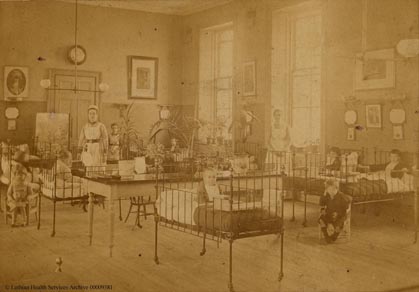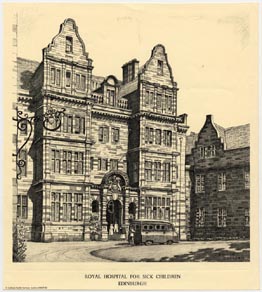Tales from the Archive
The Story of the 'Sick Kids' Hospital
The Royal Edinburgh Hospital for Sick Children celebrates its 150th anniversary in 2010, it continues to fulfil the wishes of its founders who were moved by the plight of sick children in mid-nineteenth century Edinburgh.
Beginnings
“ the mortality which takes place among children, and in particular among the children of the poorer classes, calls for an immediate effort to alleviate so much suffering and avert so great a loss of life; and that for this purpose it is necessary that a suitable hospital be provided in some salubrious locality in or near Edinburgh.”
This statement of intent appears in the minutes of the Promoters for a Hospital for Sick Children in April 1859. The group formed in response to a series of letters published in the Scotsman in early 1859 which called for the establishment of a hospital where children could be treated separately to adults. Like the Royal Infirmary of Edinburgh it was to be a voluntary hospital, financed through philanthropy and by attracting subscriptions from private donors and organisations. The promoters set about securing funding for the hospital, appointing staff and finding suitable premises. By the end of 1859, a house at 7 Lauriston Lane had been leased and was furnished with eight iron beds measuring five feet long by three feet, two inches wide, and four measuring four feet long by two feet, three inches wide. The first patient, Mary Sutherland aged 1 ¼ years was admitted on 15th February 1860 suffering from dentition of bronchitis (bronchitis brought on by teething). She was discharged recovered on 18th October.
Extract from Register of In-patients showing Mary Sutherland's admission
Meadowside House
It quickly became apparent that the Lauriston Lane building could not accommodate the numbers of children requiring treatment and, in 1861, the Contributors drew up plans to acquire larger premises which would include more beds and a separate fever ward. They instituted a building fund for which all sorts of fundraising initiatives were created; the Ladies’ Committee held a bazaar over five nights which added £1,300 to the appeal and Dinah Craik, the “accomplished authoress of John Halifax, Gentleman” lent her support which drew in many donations. As a result, Meadowside House was purchased and refurbished for the sum of £5,500. It opened in 1863 and, granted royal patronage by Queen Victoria, became the Royal Edinburgh Hospital for Sick Children (REHSC). It had 40 beds and the separate fever ward that had been hoped for. A further 30 beds were added with the addition of a new wing in 1870.
 |
 |
Click on the images above to view larger versions.
Plewlands House & Sciennes Road
As the demand continued to grow, and an outbreak of typhoid fever within the hospital caused the death of a nurse, new premises were once again sought. In 1890 all of the patients were moved to Plewlands House in Morningside whilst a new, permanent site could be found.
By the 1890s, the hospital had a large network of contributors throughout Scotland and received subscriptions in the region of £7,000 to £8,000 each year. Companies, churches, and individuals all gave money whilst charity events such as dances and concerts continued to be held for the cause. In 1895 the current building at Sciennes Road was purpose built at a cost of nearly £50,000 and opened by Princess Beatrice.
Achievements
Dr Joseph Bell, on whom Sherlock Holmes was modelled, was the first surgeon to be appointed at the hospital in 1887 and remained there until he retired. He provided a new dimension to the hospital where previously there had been no surgical department; by 1892 the surgical wards were full of children injured in cart and tram accidents, but the largest number were treated as the result of joint disease, especially of the spine and hip.
The REHSC established a Department of Medical Electricity in 1897, only two years after the discovery of x-rays. In 1913 the Department for the Diseases of Ear, Nose and Throat in Childhood was opened, the only such ward in Britain at that time. Throughout its history it has had strong ties with the University of Edinburgh, working to develop the field of paediatrics and training students in this discipline. After the arrival of the NHS, the hospital continued to innovate: a new Ear, Nose and Throat operating theatre was built, the Department of Psychological Medicine was established and advances were seen in anaesthesia, transfusion and burns treatment. These innovations have continued: in the last decade it has installed a hi-tech baby pod (the first of its kind in Scotland) and was the first in Europe to fit a hi-tech operating system which allows more keyhole surgery.
The Future
The hospital is scheduled to move from Sciennes to a new building at Little France, next to the Royal Infirmary of Edinburgh, in 2013. There, it will benefit from the most up to date technology, and the proximity of world class facilities at the Royal Infirmary. After 150 years, the vision of the founders continues to flourish: a hospital providing the best care for the city’s sick children, and those from further afield.
LHSA Sources on the Royal Edinburgh Hospital for Sick Children
The following collections are recommended for research into the REHSC using LHSA material:
Royal Edinburgh Hospital for Sick Children
References
Liebow E, Dr Joe Bell, Bowling Green University Popular Press, 1982
Mackaill A. & Kemp, D. Conan Doyle & Joseph Bell The Real Sherlock Holmes, Royal College of Surgeons of Edinburgh, 2007
Guthrie, D Royal Edinburgh Hospital for Sick Children, 1860 – 1960, E & S Livingstone Ltd, 1960
Designed by the Learning Technology Section, © The University of Edinburgh

